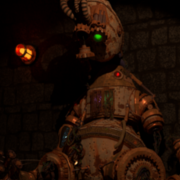Just looking for some general advice/guidlines when making clothing and how to handle armatures with it.
For reference, I'm using blender 2.72.
So, when I create a model, then create clothing for it, then try to rig an armature to it, I'm having a couple of issues. The larger issue is the armature binds to the model, and more or less ignores the clothing, as it's above the other layer, even if I join the body and clothing into one object.
I am using automatic weights when binding the armature. I can go through and hand weight paint everything, but it's incredibly time consuming, a little awkward as there are multiple layers with the model and clothing, and the process is prone to error (I always seem to accidentally get some wrong vertices in there, say from the opposite side of the model, and it throws off everything). I much prefer to use the automatic weights, and just fix whatever little issues that are created, but with the clothing, it's pretty much the entirety of the cloth that doesn't get bound to the armature.
Offhand, I imagine I can dissolve the vertices of the model that are under the clothing, but that creates issues as well.
Anyhow, I was curious how some of the more experienced of you folk go about this. Do you just buckle down and hand weight-paint everything, or is there a method I'm unaware of? Thanks for any help! :)








